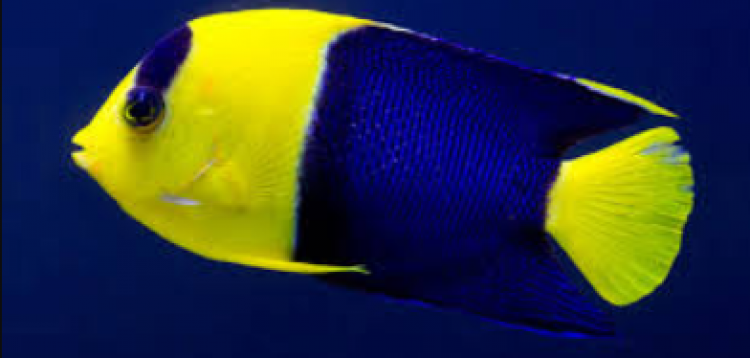- Name:
Blueface Angelfish
(View AKA's) - Family: Pomacanthidae
- Species: Angel Large
- Scientific Name: Pomacanthus xanthometopon


General info about Blueface Angelfish
The adult and juvenile Blueface Angelfish differ markedly in coloration. As a juvenile, the body is covered with alternating vertical stripes of black, white, and sapphire blue. Upon growing to approximately five inches, the juvenile begins to morph into its adult coloration of pale yellow with bluish scales and a bright-yellow pectoral fin. It has a mottled-blue face with a yellow mask that extends from eye to eye but not much beyond each eye. There is also an eyespot at the caudal end of the dorsal fin. A large tank with numerous hiding places and large amounts of live rock for grazing will offer a good environment. Not a good reef dweller, the Blueface Angelfish is prone to nip at stony and soft corals (sessile invertebrates) and clam mantles. The Blueface Angelfish is best kept as the only angelfish, as it is prone to becoming territorial when it is the largest fish in the tank.
Blueface angelfish are one of the reef inhabitants that communicate by making grunts which are audible to divers. They make these sounds to defend their territory against other competing blueface angelfish.
Blueface Angelfish Diet & Nutrition
The Bluefaced angelfish feeds mainly on sponges and tunicates. It has also been observed to feed on algae and other encrusting organisms. In the tank they may be fed with food preparations containing vegetable based materials containing sponge and meaty food such as chopped squid, scallops, and shrimp.
Determining Sex of Blueface Angelfish
Sexual dimorphism has not been observed for the Bluefaced angelfish.
Breeding & Spawning Blueface Angelfish
Breeding has not yet been done in captivity as well as larval rearing in the tank. However, they form lasting pairs in the wild and display a "happy" dance when they reunite with their mates after being separated for some time. In the wild, Bluefaced Angelfish have been observed to hybridize with the Sixbar Angelfish or Sixbanded Angelfish Pomacanthus sexstriatus and with the Blue-girdled Angelfish or Majestic Angelfish Pomacanthus navarchus.
Common Diseases with Blueface Angelfish
Highly prone to physical stress if not placed in a large tank.
Blueface Angelfish Origin
This species is found in the eastern part of the tropical Indo-Pacific. Its range includes the Maldive Islands, Malaysia, Indonesia, Japan, Taiwan, the Philippines, northern Australia and Micronesia.
Caution with Blueface Angelfish
Adult Bluefaced angelfish may pick on are large polyp stony (LPS) corals, zoanthids and other polyp corals, along with Tridacnid clams and other similar invertebrates.
It is a sem-aggressive species when interacting with other fishes such as gobies, clownfish and blennies and more peaceful tankmates if the aquarium is cramped. Should not be kept with other angelfish, fishes that are of similar sized and color, and more aggressive fishes.
Acclimating Blueface Angelfish
Provide plenty of hiding places in the tank, since the Bluefaced angelfish is especially associated with areas that have caves and large crevices. Requires a mature and established tank, at least 220 gallons for adults, with sponge, tunicate and algal growth.
Original Detail
| Name | Species | Family | Scientific Name | More Detail | Added by |
|---|---|---|---|---|---|
| Blueface Angelfish | Angel Large | Pomacanthidae | Pomacanthus xanthometopon | The adult and juvenile Blueface Angelfish differ markedly in coloration. As a juvenile, the body is covered with alternating vertical stripes of black, white, and sapphire blue. Upon growing to approximately five inches, the juvenile begins to morph into its adult coloration of pale yellow with bluish scales and a bright-yellow pectoral fin. It has a mottled-blue face with a yellow mask that extends from eye to eye but not much beyond each eye. There is also an eyespot at the caudal end of the dorsal fin. A large tank with numerous hiding places and large amounts of live rock for grazing will offer a good environment. Not a good reef dweller, the Blueface Angelfish is prone to nip at stony and soft corals (sessile invertebrates) and clam mantles. The Blueface Angelfish is best kept as the only angelfish, as it is prone to becoming territorial when it is the largest fish in the tank. Blueface angelfish are one of the reef inhabitants that communicate by making grunts which are audible to divers. They make these sounds to defend their territory against other competing blueface angelfish. |
PalaciosAn |
Changed by users
| Submitted Date | Submitted By | Status | Action |
|---|




